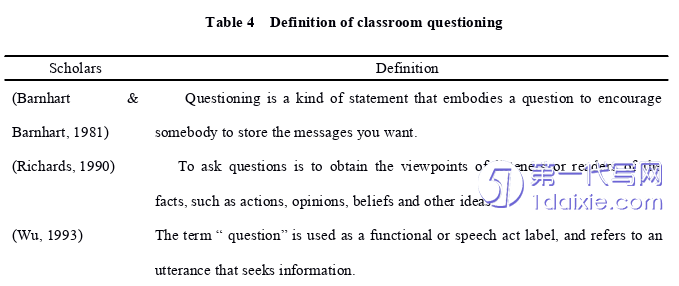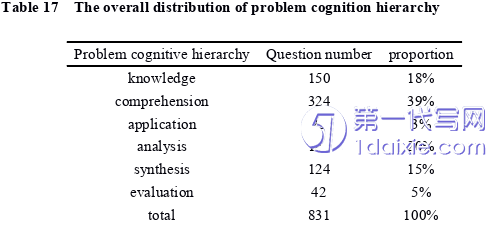本文是一篇英语论文,本研究结合前人研究、阅读国内外相关理论和文献,对高中英语阅读课中教师提问策略对学生批判性思维能力的培养进行了研究,基于对这三个研究问题的回答,本文有一些主要发现。
Chapter One Literature Review
1.1 Studies on critical thinking
In the field of education,Delphi Report,the class level model Anderson,Krathwohl&Bloom and the ternary structure model of Paul&Elder,have the most dominant influence.
1.1.1 Definition of critical thinking
Critical thinking is the most important key words in this thesis,so it is absolutelyimportant for us to comprehend this word.After reading a large amount of relevantliterature,it can be concluded that,until now,there is not an official or very standarddefinition of it.However,quantities of authors have studied it and gave it their ownunderstanding and definition.
In Oxford University Press,the words“criticize”or“criticise”s meaning is that“tojudge the good and bad qualities of something”.Moreover,in Webster's New WorldDictionary,the word“critical”means“Try to make objective judgments about what isgood or bad”.Besides these,etymologically,the word“critical”has two Greek etymology.The first one is“kritikos”,which means resolving power and sound judgment.The secondone is“kriterion”,which means criterion.This demonstrates that the emerging of criticize follows judgment.
“Reflective Thinking”,which was put forward by Dewey,is the most comprehensiveand representative theory,and it is the base of critical thinking.In Dewey’s book-How wethink,he holds the view that the better way of thinking to be considered is called reflectivethinking:the kind of thinking involves that turning a problem over in the mind and overand over again seriously and repeatedly(Dewey,1933).Except that,table 1 shows severalessential definitions of critical thinking.Here the list is presented in chronological order.
1.2 Studies on classroom questioning
A number of studies have found that there are some connection between classroomquestioning and critical thinking.
Wangqiang holds the view that questioning as the most common form of interaction isa critical skill for teachers and students.Beyond that,suitable questioning even promotepupils’thinking not only in the concrete and factual aspects but also the analytically andevaluative aspects(Wangqiang,2015).Then it could help students establish keyunderstandings from the perspective of a sequence.And it can also have a promotion inreasoning,problem solving,evaluation,students’leaning style.Because of that,teachersare prone to use questions in the English classes.(Chrstenbury,1983).
1.2.1 Definition of classroom questioning
John Dewey once said:“What is question,you ask?Everything.It is the way ofevoking stimulating response or stultifying inquiry.It is,in essence,the very core of teaching.”Hence,questioning in teach is so important that there are so many authors whostudy it.
“Quaestus”is the etymology of the word“questioning”,which means to ask or seek.From this aspect,we can conclude that the meaning of the word“question”may connectwith asking and answering.Here are some scholars who have gotten out the definition ofclassroom questioning.

Chapter Two Theoretical Foundations and the Research Methodology
2.1 Bloom’s Taxonomy
As people become more aware of the importance of critical thinking,The relatedtheoretical basis is also increasingly rich.About how to develop critical thinking,manydifferent researches have been studied by authors.The underlying premise of this book isbased upon Bloom’s Taxonomy.
2.1.1 The domains of Bloom’s Taxonomy
As what mentioned before,in Esther Fusco’s book,she divides questions into threelevels,which are lateral questions,inferential questions and meta cognitive questions.MostEnglish teachers are restricted to literal questions for various reasons,however,as anattractive and successful class,all of the types should be involved.Bloom’s categoriescreate a manageable questioning system and provide a strategy for constructing questionsthat encourages teachers to move from the literal level to the inferential level of thinking (Esther Fusco,2012).
Bloom’s taxonomy is designed to be a classification of the student behaviors whichrepresent the intended outcomes of the educational process.It follows the law that“human’s cognition is from simplification to complexion,from specification to abstraction”as thetheoretical basis(Bloom,1956).The Handbook(Bloom’s taxonomy)put gaining evidenceand demonstrating that the students have get the action what they want as emphasizing.
This book(Bloom,1956)’s original plans called for a complete taxonomy in threemajor parts——the cognitive,the effective,and the psycho motor domains.About the firstone,cognitive domain,which is involved in this Handbook,deals with the recall orreorganization concerning knowledge and goals for the development of intellectual ability.This is the most central domain among the current test development work.Morespecifically,table 11 shows hierarchical classification of problem cognition.
2.2 The research methodology
In this part,the research questions,participants,instruments,research procedures,datacollection and data analysis will be discussed.
2.2.1 Research questions
The connotation of critical thinking,classroom question and reading teacher have been elaborated in literature review,so based on that,the following three researchquestions are provided.
1.How do high school English teachers understand and apply the role of questioningstrategies in developing critical thinking in English reading classes?
2.What are the problems of critical thinking in senior high school students?
3.How to improve students'critical thinking by changing teachers'questioningstrategies in English reading class?
Chapter Three Results and Discussion..........................46
3.1 Results on critical thinking skills and disposition...........................46
3.1.1 The overall distribution of problem cognition hierarchy and critical thinkingskill grades in reading class......................46
3.1.2 The comparing between different teachers and their cognitive leveldistribution of classroom questions in reading class on critical thinking skills..................47
Conclusion...................................69
Chapter Three Results and Discussion
3.1 Results on critical thinking skills and disposition
Since there are many English classes in senior high school,the author chose eightrepresentative classes of four teachers in total.The eight lessons were recorded andtranscribed.And picking out the questions from these eight lessons,and encode all thequestions.The author analyzed the relationship between teachers'questioning and students'critical thinking training from various dimensions,the results are as follows.
3.1.1 The overall distribution of problem cognition hierarchy and critical thinkingskill grades in reading class
The questions’amount of the four teachers’eight classes is 831,as table 17 shows.The questions are distributed in six different cognitive levels,among them,comprehensivequestions occupied the most,after that the questions are analysis,knowledge and synthesisquestions.And evaluation and application questions hold the least.

Conclusion
After collecting data and analyzing results and discussion,in this chapter,it will be theconclusion of this research.One of the main goals of this thesis is to attempt to make aninvestigation of the influence of teachers'questioning strategies on students'criticalthinking.It consists of four parts.
Part one will summarize the major findings to answer three research questions andreveal some current situations of classroom questioning in English reading classes based onsenior high school.Part two comes the implications of the research.And part three and fourcome to limitations of this study and suggestions for further researchers.
1)Major findings
In view of previous studies,reading relative theories and literature domestic as well asoverseas,the present study aims at the research on the cultivation of students’criticalthinking ability by teachers'questioning strategies in senior English reading class.Afterfour month’classroom observation,interviews to teachers and questionnaires,there aresome major findings based on the answers to the three research questions in this thesis.
Firstly,as for question number one:how do senior high school English teachersunderstand and apply the role of questioning strategies in developing critical thinking inEnglish reading classes?Based on the research,75%of the English teachers hold the ideathat students need to develop critical thinking.In addition to this,English reading coursesin senior high schools emphasize the cultivation of students'thinking quality.Moreover,allthe teachers have accepted relevant trainings.They have realized that as teachers,theyshould have such consciousness to cultivate the thinking quality of students.However,25%of the English teachers don’t have the concept of cultivating students’critical thinking,even there are 38%of the English teachers haven’t the aware of the connection betweenclassroom questioning and critical thinking cultivation.Whereas,there are still 25%of teachers with such awareness,who have already begun to implement it in the classroom,also they have already achieved considerable results.
reference(omitted)
